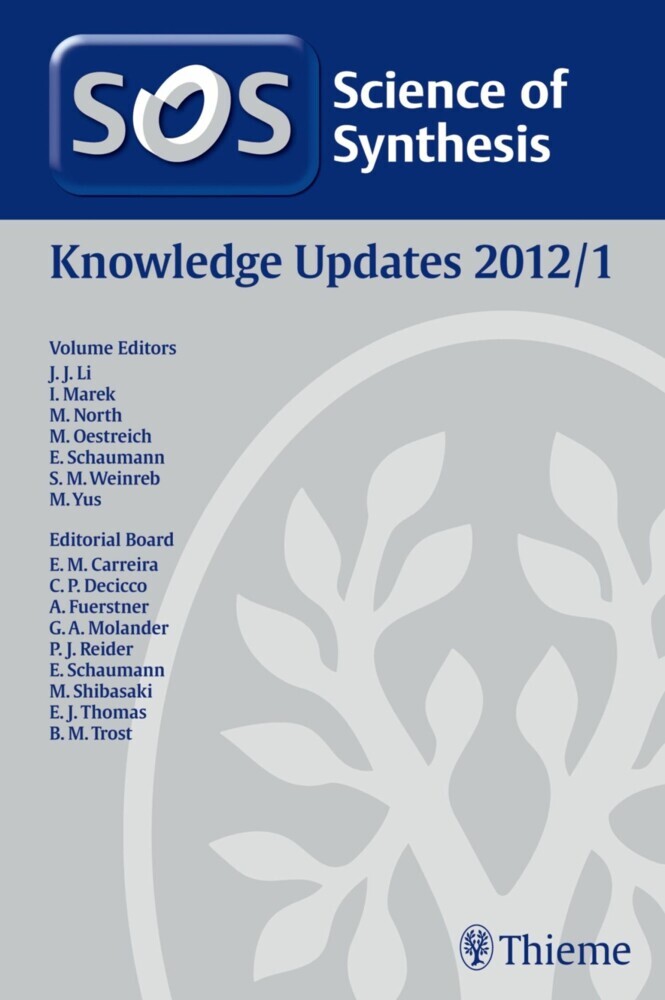Science of Synthesis Knowledge Updates 2012 Vol. 4
Science of Synthesis is a reference work for preparative methods in synthetic chemistry. Its product-based classification system enables chemists to easily find solutions to their synthetic problems.
Key Features:
- Critical selection of reliable synthetic methods, saving the researcher the time required to find procedures in the primary literature.
- Expertise provided by leading chemists.
- Detailed experimental procedures.
- The information is highly organized in a logical format to allow easy access to the relevant information.
The Science of Synthesis Editorial Board, together with the volume editors and authors, is constantly reviewing the whole field of synthetic organic chemistry as presented in Science of Synthesis and evaluating significant developments in synthetic methodology. Four annual volumes updating content across all categories ensure that you always have access to state-of-the-art synthetic methodology.
1;Science of Synthesis: Knowledge Updates 2012/4;1 1.1;Title page;5 1.2;Imprint;7 1.3;Preface;8 1.4;Abstracts;10 1.5;Overview;16 1.6;Table of Contents;18 1.7;Volume 1: Compounds with Transition Metal--Carbon p-Bonds and Compounds of Groups 10-8 (Ni, Pd, Pt, Co, Rh, Ir, Fe, Ru, Os);30 1.7.1;1.2 Product Class 2: Organometallic Complexes of Palladium;30 1.7.1.1;1.2.5 Product Subclass 5: Palladium(III)-Containing Complexes;30 1.7.1.1.1;1.2.5.1 Synthesis of Palladium(III)-Containing Complexes;30 1.7.1.1.1.1;1.2.5.1.1 Mononuclear Palladium(III) Complexes;30 1.7.1.1.1.1.1;1.2.5.1.1.1 Method 1: Disproportionation of Palladium(II) Complexes;31 1.7.1.1.1.1.2;1.2.5.1.1.2 Method 2: Oxidation of Palladium(II) Complexes with Perchloric Acid;31 1.7.1.1.1.1.3;1.2.5.1.1.3 Method 3: Electrochemical Oxidation of Palladium(II) Complexes;32 1.7.1.1.1.1.4;1.2.5.1.1.4 Method 4: Oxidation of Palladium(II) with Single-Electron Oxidants;33 1.7.1.1.1.1.5;1.2.5.1.1.5 Method 5: Oxidation of Palladium(II) Complexes with Oxygen;33 1.7.1.1.1.2;1.2.5.1.2 Binuclear Palladium(III) Complexes without a Pd--Pd Bond;34 1.7.1.1.1.2.1;1.2.5.1.2.1 Method 1: Electrochemical Oxidation;34 1.7.1.1.1.2.2;1.2.5.1.2.2 Method 2: Comproportionation of Palladium(II) and Palladium(IV) Complexes;35 1.7.1.1.1.3;1.2.5.1.3 Binuclear Palladium(2.5) Complexes with a Pd--Pd Bond Order of 0.5;36 1.7.1.1.1.3.1;1.2.5.1.3.1 Method 1: Binuclear Palladium(2.5) Complexes by Electrochemical Oxidation;36 1.7.1.1.1.3.2;1.2.5.1.3.2 Method 2: Binuclear Palladium(2.5) Complexes Using Single-Electron Oxidants;37 1.7.1.1.1.4;1.2.5.1.4 Tetrabridged Binuclear Palladium(III) Complexes with a Pd--Pd Bond;38 1.7.1.1.1.4.1;1.2.5.1.4.1 Method 1: Binuclear Palladium(III) Complexes by Oxidation with Hypervalent Iodine;38 1.7.1.1.1.4.2;1.2.5.1.4.2 Method 2: Inorganic Binuclear Palladium(III) Complexes via Ligand Metathesis;39 1.7.1.1.1.4.3;1.2.5.1.4.3 Method 3: Organometallic Tetrabridged Binuclear Palladium(III) Complexes;39 1.7.1.1.1.5;1.2.5.1.5 Binuclear Palladium(III) Complexes Supported by Two Bridging Ligands;41 1.7.1.1.1.5.1;1.2.5.1.5.1 Method 1: Oxidation with Hypervalent Iodine Reagents;41 1.7.1.1.1.5.2;1.2.5.1.5.2 Method 2: Oxidation with Peroxides;42 1.7.1.1.1.5.3;1.2.5.1.5.3 Method 3: Oxidation with Halogens;42 1.7.1.1.1.6;1.2.5.1.6 Unbridged Pd(III)--Pd(III) Bonds;43 1.7.1.1.1.6.1;1.2.5.1.6.1 Method 1: Oxidation of Acetate-Bridged Binuclear Palladium(III) Complexes with Xenon Difluoride;43 1.7.1.1.2;1.2.5.2 Stoichiometric Organometallic Chemistry of Isolated Palladium(III) Complexes;45 1.7.1.1.2.1;1.2.5.2.1 Organometallic Chemistry of Mononuclear Palladium(III) Complexes;45 1.7.1.1.2.1.1;1.2.5.2.1.1 Method 1: C--C Bond-Forming Reactions of Mononuclear Palladium(III) Complexes;45 1.7.1.1.2.1.2;1.2.5.2.1.2 Method 2: C--C Bond-Forming Reactions Initiated by Ligation of Anionic Donors;47 1.7.1.1.2.2;1.2.5.2.2 Organometallic Chemistry of Binuclear Palladium(III) Complexes;48 1.7.1.1.2.2.1;1.2.5.2.2.1 Method 1: C--X Bimetallic Reductive Elimination from Binuclear Palladium(III) Complexes;48 1.7.1.1.3;1.2.5.3 Organometallic Reactions Proposed To Proceed via Unobserved Mononuclear Palladium(III) Intermediates;48 1.7.1.1.3.1;1.2.5.3.1 Method 1: C--C Bond-Forming Reactions Initiated by One-Electron Oxidation of Mononuclear Palladium(II) Complexes;48 1.7.1.1.3.2;1.2.5.3.2 Method 2: Oxygen-Insertion Reactions;49 1.7.1.1.4;1.2.5.4 Binuclear Palladium(III) in the Synthesis of Mononuclear Palladium(IV) Complexes;51 1.7.1.1.4.1;1.2.5.4.1 Method 1: Pd--Pd Heterolysis in Trifluoromethylation;51 1.7.1.1.4.2;1.2.5.4.2 Method 2: Heterolysis of Unbridged Pd(III)--Pd(III) Bonds;52 1.7.1.1.5;1.2.5.5 Proposed Catalysis via Mononuclear Palladium(III) Intermediates;53 1.7.1.1.5.1;1.2.5.5.1 Method 1: Kharasch Reaction;53 1.7.1.1.6;1.2.5.6 Catalysis via Proposed Binuclear Palladium(III) Intermediates;54 1.7.1.1.6.1;1.2.5.6.1 Method 1: Binuclear Palladium(III) Intermediates in C--H Aryl
Batrice, Rami J.
Fürstner, Alois
| ISBN | 9783131788610 |
|---|---|
| Artikelnummer | 9783131788610 |
| Medientyp | E-Book - PDF |
| Copyrightjahr | 2014 |
| Verlag | Georg Thieme Verlag KG |
| Umfang | 553 Seiten |
| Sprache | Englisch |
| Kopierschutz | Digitales Wasserzeichen |











